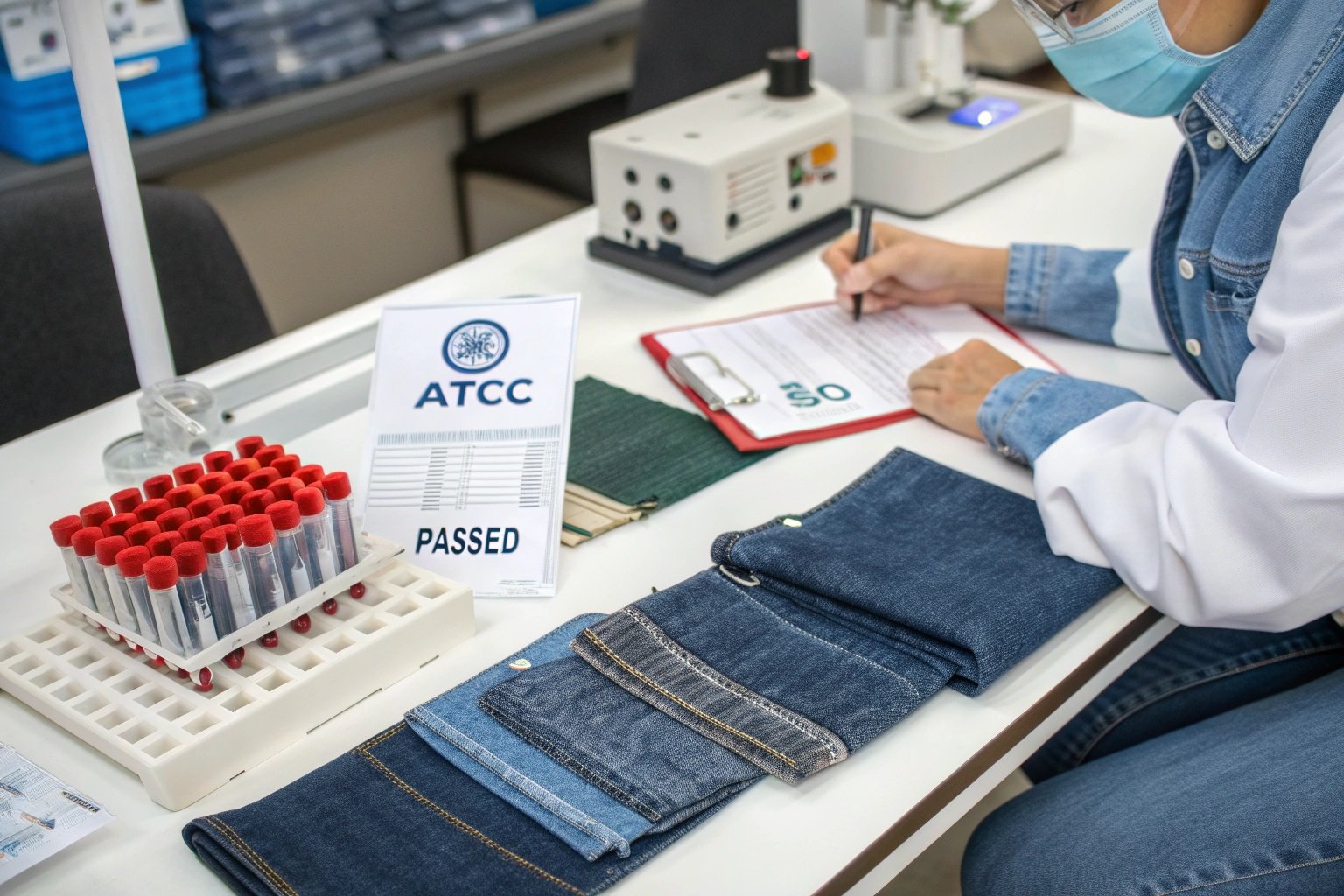Denim fading too early or unevenly can ruin your product line and disappoint customers—before they even put it in the wash.
To source denim with consistent colorfastness, partner with suppliers using certified testing methods, advanced dyeing processes, and strong quality control across batches. Verify performance with ISO or AATCC standards before bulk production.
In my years running a fabric export business, nothing causes more buyer frustration than dye inconsistencies in denim. You may love the texture and weight—but if color fades or shifts after washing, buyers won’t reorder. Let’s walk through how to get denim that holds color the right way.
Why Does Denim Colorfastness Matter in Apparel?
Denim that fades too fast isn't just a design issue—it’s a credibility killer.
Colorfastness in denim is essential for brand quality, consumer satisfaction, and long-term durability. Uneven fading, crocking, or bleeding affects product returns, retailer trust, and fashion consistency.
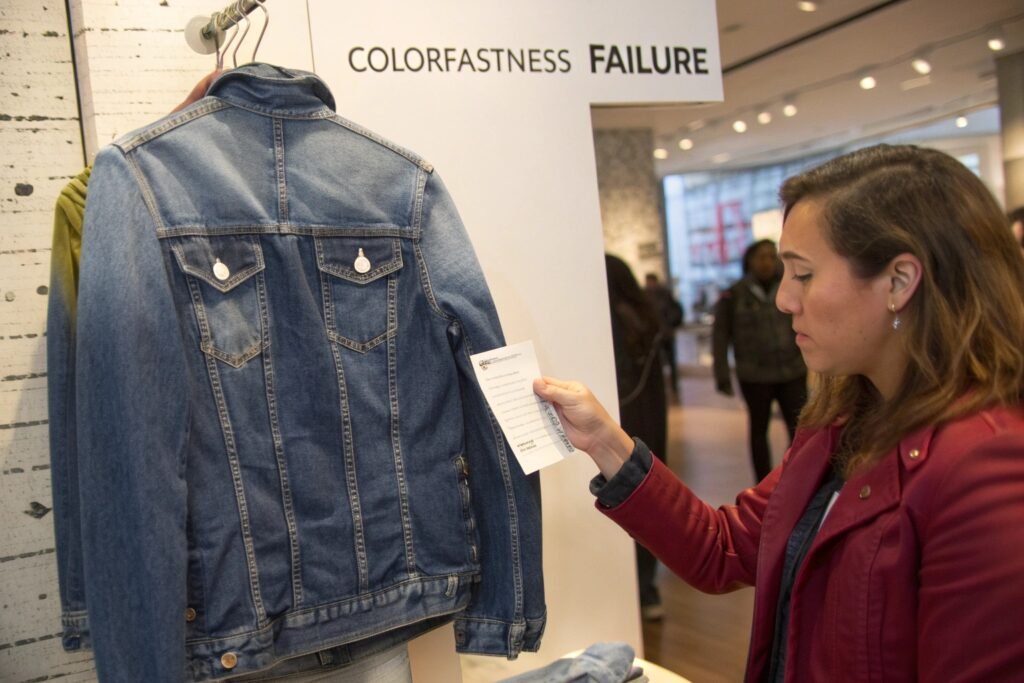
How does denim color performance impact garment value and brand trust?
Inconsistent denim fading leads to serious problems:
- Early Returns: Customers complain when their jeans fade after 1–2 washes.
- Design Disruption: Uneven tones disrupt color blocking and multi-panel construction.
- Retailer Rejection: Buyers spot crocking in QC and reject entire lots.
- Online Review Risk: Bad reviews on wash quality damage your future sales.
Think of the consumer. They pick up a dark indigo jacket and expect it to stay rich and deep for months. But if it starts turning grey at the seams or staining their white shirt collar—it’s over.
Here’s a chart showing the chain reaction:
| Colorfastness Issue | Immediate Result | Long-Term Business Effect |
|---|---|---|
| Bleeding in wash | Ruined garments nearby | Brand complaints on forums |
| Uneven batch dyeing | Style mismatches | Retail rejection |
| High crocking | Stained hands/clothes | Loss of trust in fabric source |
I’ve seen importers lose an entire U.S. retailer account just because their denim’s color wasn’t fixed properly. This problem doesn’t get solved with a refund—it gets solved with better sourcing.
Best Tests to Ensure Denim Color Consistency?
Without proper testing, even great-looking denim may fail later.
The best tests for denim colorfastness include ISO 105 and AATCC 61 standards, measuring performance under washing, rubbing, light exposure, and perspiration. These tests predict real-world fabric behavior.
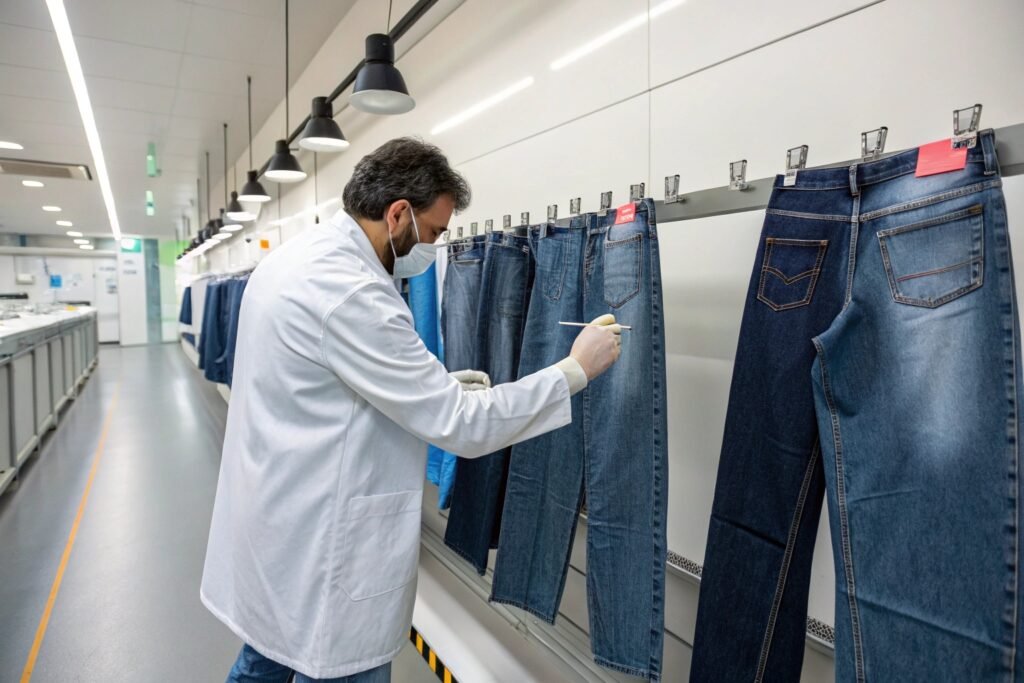
What tests should you request before placing a bulk denim order?
Here’s what we run in our CNAS-certified lab at Fumao before every denim shipment:
| Test Name | Standard Used | What It Measures |
|---|---|---|
| Colorfastness to Washing | ISO 105-C06 / AATCC 61 | How color holds up during laundering |
| Colorfastness to Rubbing | ISO 105-X12 / AATCC 8 | Transfer of dye to dry/wet surfaces |
| Colorfastness to Light | ISO 105-B02 | UV exposure resistance |
| Colorfastness to Perspiration | ISO 105-E04 | Sweat contact fading |
Each test assigns a rating from 1 (worst) to 5 (best). For premium denim, you should target:
- 4–5 on dry rubbing
- 3–4 on wet rubbing
- 4+ on washing
- 4+ on perspiration
If your supplier can’t provide certified lab results on these tests, you're gambling with your product quality. We once helped a U.S. fashion client switch suppliers because their old denim scored “2” on wet rubbing—jeans kept bleeding onto white furniture.
How often should you test denim fabric?
Every production batch. Indigo dye is notoriously tricky. Even with the same recipe, slight temperature or chemical shifts during dyeing can cause variations. At Fumao, we test each lot before shipping and include QR-coded reports showing:
- Test method
- Lab name
- Sample date
- Ratings for each category
We make sure clients don’t discover issues when it's too late—at the warehouse or retail shelf.
Top Suppliers Known for Reliable Denim Colorfastness
Not every mill gets indigo right. Few get it right every time.
The best denim suppliers for colorfastness have in-house testing labs, indigo rope dyeing or reactive dye lines, and full traceability from yarn to final fabric. Chinese suppliers like Fumao lead with batch stability and CNAS testing support.
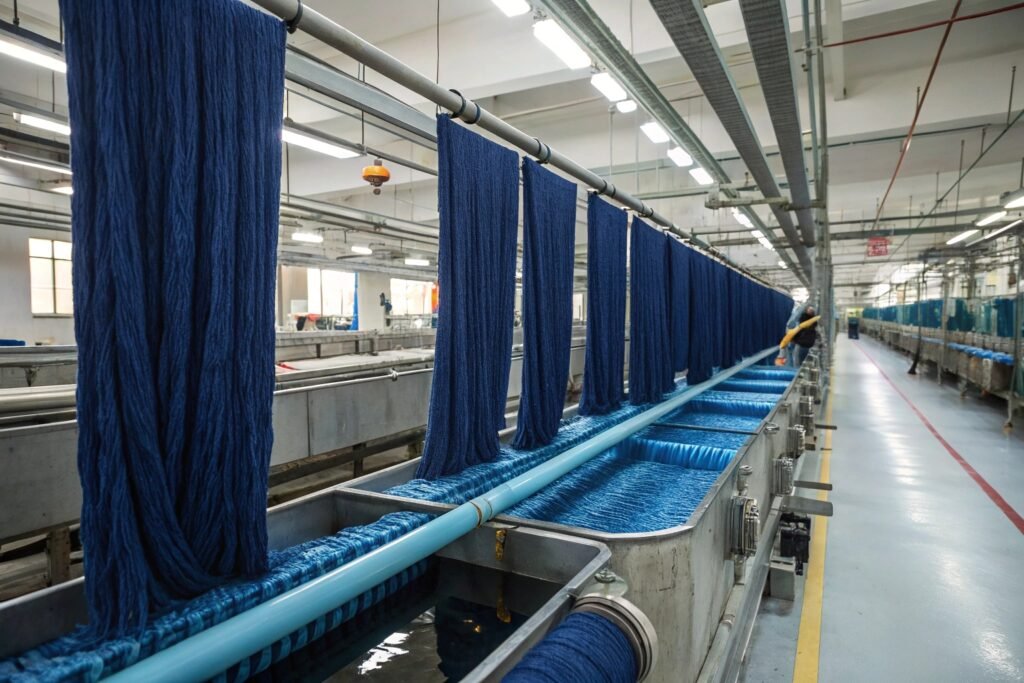
What supplier traits guarantee better denim color consistency?
Here’s what separates high-performing denim mills from the rest:
- Advanced Dyeing Systems: Indigo rope dyeing or sulfur reactive dye tanks.
- Lot Traceability: QR tracking from yarn to dye to final roll.
- In-House Testing: Lab-certified wash, rub, and light tests per lot.
- Consistent Yarn Quality: Ring-spun, combed cotton yarns for better dye bonding.
- Finishing Controls: Calendering, desizing, and enzyme wash pre-treatment.
Fumao operates with local Keqiao dye houses that specialize in deep indigo, bleached denim, and color denim blends. All finishes—like stone wash or enzyme softening—are tested for dye hold and rub stability.
Some of our European clients order three different washes from the same fabric base. We ensure every stage holds color correctly. Our testing guarantees uniform performance, from dark wash jackets to vintage fade skirts.
Which denim types perform best for colorfastness?
Different dyes behave differently. Here's a quick reference:
| Denim Type | Dye Type Used | Colorfastness Rating | Best Use Case |
|---|---|---|---|
| Deep Indigo Rope Denim | Indigo Vat Dye | Medium–High | Premium jeans & jackets |
| Reactive-Dyed Denim | Reactive Dyes | High | Uniforms & industrial wear |
| Sulfur-Dyed Color Denim | Sulfur + Reactive | Medium | Colored fashion denim |
| Enzyme-Washed Denim | Any base | Varies (Test Required) | Soft-hand lifestyle wear |
The key is not just the dye—but how it’s fixed and tested. We help our clients match dye types to their use case, and then validate colorfastness through multiple wash simulations.
How to Verify Denim Fabric Dyeing Standards?
A good supplier doesn’t hide their dyeing process—they show it off.
To verify denim dyeing standards, request documentation on dye type, dyeing method (e.g., rope vs. slasher), fixation process, and test results following ISO or AATCC methods. Always confirm through a certified third party or lab-accredited mill.
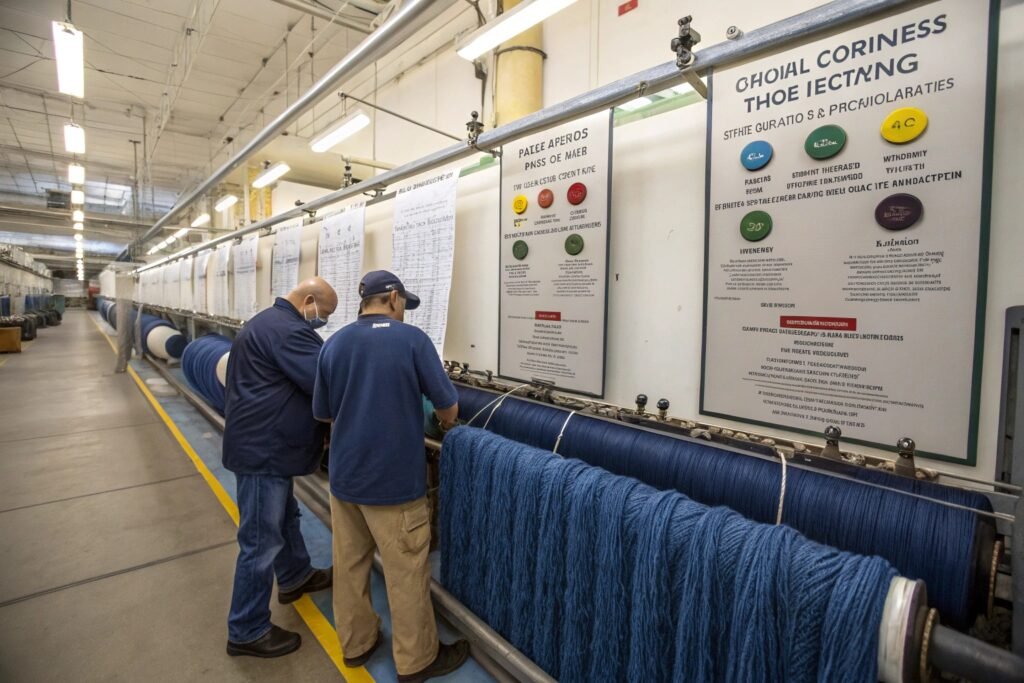
What questions should you ask your supplier about denim dyeing?
Don’t just ask “is this good denim?” Ask specifics:
- What dyeing method was used?
- Is the dye vat-controlled for temperature and pH?
- Are fixation agents applied? Which ones?
- What washing agents are used post-dyeing?
- Can you share AATCC/ISO colorfastness test reports?
- Do you have repeatable shade batch records?
If they can’t answer—or say “don’t worry”—worry.
Fumao provides dyeing logs for each denim program we run. Clients get a digital “dye passport” with:
- Shade tolerance chart
- Recipe ratio logs
- Dye method (rope/slasher/reactive)
- Fixation chemical info
- Batch-level lab results
This info not only proves performance—it helps clients streamline compliance paperwork for brands or customs.
How do dyeing methods affect denim color stability?
Here’s a quick breakdown:
| Dyeing Method | Description | Color Stability | Cost | Risk Level |
|---|---|---|---|---|
| Rope Dyeing | Yarn dyed in loops via indigo vats | Medium–High | High | Low |
| Slasher Dyeing | Sheet of yarns dyed simultaneously | Medium | Medium | Medium |
| Reactive Dyeing | Dye molecules bond chemically to fiber | Very High | High | Low |
| Pigment Printing | Surface layer printing only | Low | Low | Very High |
Rope dyeing offers the authentic fading that jeans lovers want, but it's harder to control. Reactive dyeing is better for workwear or colored denim needing consistency. We help buyers select based on budget, fashion purpose, and end-user wash habits.
Conclusion
Denim colorfastness isn’t luck—it’s process, testing, and supplier discipline. At Fumao, we back every roll with test results and dye traceability, so you can create denim apparel with confidence and consistency.

